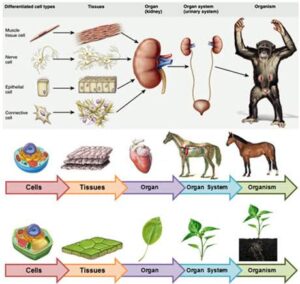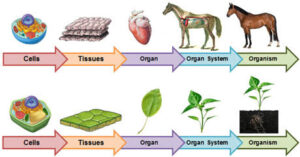Back to: ZOOLOGY 100 Level
It’s a joy to have you back again. You’re doing such a great job, and I hope you know that I’m really proud of you! Today, we’re going to look at something that shows just how wonderfully organised living things are. From the tiniest cell in your body to your full self as a human being—it’s all connected. This lesson will help you understand how everything fits together like a puzzle to keep life going smoothly.
Cell → Tissue → Organ → System → Organism
Cells: The Building Blocks of Life
Every living thing starts with a cell. Cells are the smallest units of life, just like bricks are the smallest parts of a house. Even though they are tiny, cells carry out important tasks like producing energy, cleaning waste, and helping with growth. Some organisms, like bacteria, are made of just one cell, while others, like humans and goats, have trillions!

Tissues: Groups of Similar Cells Working Together
When many similar cells come together to do the same job, they form a tissue. Think of it like several bricks stacked together to make a wall. The wall is stronger and more useful than just a single brick. In animals, we have different types of tissues like muscular tissue (for movement), connective tissue (for support), epithelial tissue (for covering and protection), and nervous tissue (for sending signals).
Organs: Structures Made of Different Tissues
Now, when different tissues come together to do a more complex job, they form an organ. For example, your heart is an organ. It’s made up of muscular tissue (to pump blood), connective tissue (to hold things together), and nervous tissue (to control the heartbeat). Other examples of organs include the brain, liver, kidneys, and stomach.
Systems: Organs Working Together for Bigger Jobs
Several organs can work together as a system to carry out larger functions. Your digestive system, for example, includes the mouth, stomach, intestines, and liver—all working to break down and absorb food. Other systems include the circulatory system (heart and blood vessels), the respiratory system (lungs and airways), and the nervous system (brain, spinal cord, nerves).

Organism: The Complete Living Being
When all the systems work together in harmony, they form a complete organism. That’s you, me, a chicken, or even a tree. Every organism has all these levels—cells, tissues, organs, and systems—working together to keep it alive and active.
Summary
- Cells are the smallest units of life.
- Tissues are made of similar cells doing a specific job.
- Organs are made of different tissues working together.
- Systems are groups of organs working to perform complex functions.
- Organisms are complete living beings made up of all these parts.
Evaluation
- What is the relationship between cells and tissues?
- Give an example of an organ and name two types of tissue found in it.
- Which system helps with breathing and which organs are involved?
- How do systems work together to form an organism?
Well done, my brilliant learner!
You’ve just unlocked another level of understanding in your learning journey. Every time you take a step like this, you’re growing wiser, stronger, and closer to your goals. Keep believing in yourself and remember—Afrilearn is here to make learning easy, fun, and exciting for you. See you in the next lesson!
